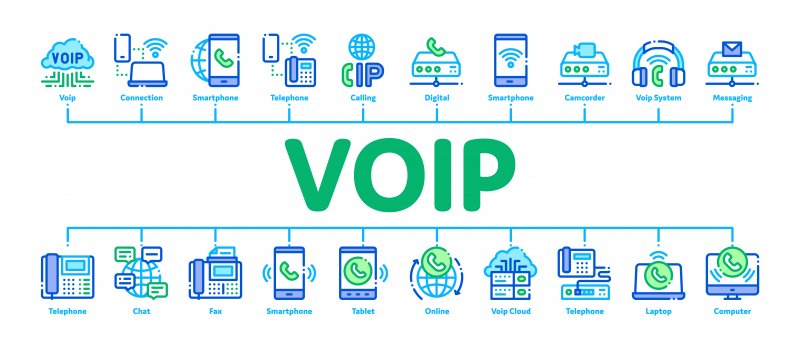Many people have become familiar with VoIP. Voice over Internet Protocol made cost-effective calling over the internet possible, and for decades, people have used the technology for inexpensive, high-quality phone calls.
However, a related technology has become equally important, especially for businesses. The Session Initiation Protocol is a popular way to deploy VoIP, and its creation in 1996 is a big reason why VoIP is so available today.
If you’re planning on running a cloud private branch exchange using VoIP, you’ll likely also be relying on SIP trunking. Learn a little more about what SIP trunk port numbers do and the number of SIP trunks you need.
Key Takeaways:
- SIP trunking enables VoIP for voice calls and multimedia communications channels.
- You can access an unlimited number of business lines for a low cost with SIP trunking because the system is virtual.
- The most important SIP trunk port numbers are 5060 and 5061, which carry the bulk of your VoIP communications, but you won’t need to worry about that with world-class support from Intermedia.
What Is SIP, and How Does It Relate to VoIP?
VoIP is the original technology that enabled digital calls over internet lines. However, industry experts had to resolve how to enable those transmissions across systems and providers.
SIP technology was the answer and has become the industry standard for enabling VoIP transmissions. An oversimplified explanation is that a VoIP call is like a subway car carrying your messages back and forth, and SIP is like the station and tracks that allow each car to get where it’s going.
SIP handles the process of sending a signal that invites a recipient to a call. It maintains the connection and ends it when one of the callers disconnects.
Beyond that, SIP allowed the addition of video and text messaging over your VoIP lines. That’s why you can easily elevate your cloud-based PBX system into a full-fledged unified communications service without purchasing any additional devices or system hardware.
What Is a SIP Trunk?
Trunking is the process that connects your PBX lines to each other and the outside world, thus enabling calls. Where did the expression “trunk” come from? Originally, you connected an analog PBX to the outside world with a physical trunk device.
This is another handy illustration. A PBX is full of separate extensions, or branches, like the branches in a tree. These would interconnect and reach the outside world of public switched telephone lines with a trunk.
Therefore, a trunk is basically a central connection to a group of lines. Because of the limitations of physical hardware, the maximum amount of lines in an old-school T3 trunk was 28. If you needed to connect more than that, you had to get more trunks.
This all changed dramatically with the introduction of SIP technology. Because everything is virtual, you can have an endless number of lines on a single SIP trunk.

How Many SIP Trunks Does Your Business Need?
You’ve probably already figured out the answer to this question: You only need one SIP trunk! That’s because these virtual solutions make it possible to put unlimited lines (or “channels”) on your system.
Therefore, the real question is: How many channels do you need when SIP trunking?
Though the solution is virtual, the calls, conferences, and messages passing through your system will be transmitting data. Your provider securely manages this from data centers behind the scenes, which is why there is still a reasonable cost for professional VoIP and SIP trunking.
Likewise, keep in mind that the number of channels and calls you’re placing will require sufficient internet bandwidth for smooth and clear connections. Discuss this with your communications service provider to understand whether you need to upgrade your internet to a service that is suitable for a business line.
What Is a SIP Trunk Port Number For?
A discussion around SIP port numbers can quickly get very technical. You don’t need to fully understand it unless you’re an IT professional.
However, what you should know is that these ports are virtual connections that control the transfer of data for different activities. The two primary port numbers for SIP traffic are 5060 and 5061.
Port 5060 handles the bulk of your VoIP calls. It allows quick, nonencrypted connections. Port 5061 only allows traffic with transport layer security.
In the past, you had to be aware of these numbers for troubleshooting. Now that you can get a feature-rich cloud-based VoIP business line, you would rarely have to concern yourself with those numbers, if at all. Your provider should offer round-the-clock support to check up on your system and walk you step by step through fixing any issues.
What Are the Benefits of SIP Trunking?
If you already have a legacy PBX, you might wonder if it’s worth switching to the cloud. It absolutely is for the following reasons:
- Greater cost savings: Not only are virtual systems less expensive to start with, but you also won’t have to pay for extra lines because you can seamlessly scale up or down as necessary.
- Remote and hybrid capabilities: Your secure communications system is available wherever you have internet, allowing for trustworthy communications with your team, no matter where they are.
- Reliable, future-proof technology: Your provider backs up your service with multiple data centers, allowing you to keep business continuity in the face of outages or disasters.
There are many other advantages of a cloud-based phone service. If you need to investigate more, check out the stories of Intermedia customers who successfully moved to the cloud.

Are You Ready To Bring Your PBX Into the 21st Century With SIP Trunking?
SIP trunking makes getting a virtual business line easier than ever. Many companies are even able to get their cloud-based PBX functional within a matter of days or the same day!
To access the benefits of SIP trunking, contact us at Intermedia. Whether you’re upgrading a legacy system or starting from scratch, we’ll help you increase flexibility while saving on costs with a modern business phone service.
April 18, 2024
Explore other posts on these topics: Unified Communications





